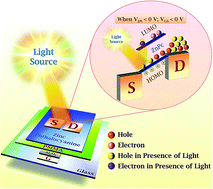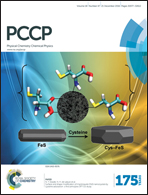Photosensitive organic field effect transistors: the influence of ZnPc morphology and bilayer dielectrics for achieving a low operating voltage and low bias stress effect†
Abstract
Photosensitive-organic field effect transistors (PS-OFETs) based on a morphology controlled zinc phthalocyanine (ZnPc) layer, with an inorganic–organic bilayer gate dielectric system, fabricated on a glass substrate showed remarkable efficiency as light sensors at various incident optical powers. The indium tin oxide (ITO) and Si/SiO2 free low-cost OFET devices show low bias stress and a reduced operating voltage with aluminum oxide and poly(methyl methacrylate) (Al2O3/PMMA) as bilayer gate dielectrics and copper (Cu) as a top contact. They exhibit excellent p-channel behavior with a remarkable photo-responsivity of 2679.40 A W−1 and a photo-ON/OFF current ratio of 933.56 with a very low operating voltage (0 to −8 V), which have not been observed previously. The bias stress effect of the device was investigated under both light and dark conditions in a vacuum. It was observed that the effect of the stress is extremely small in the presence of light (a decay of IDS of ∼ 20% after 30 min) compared to the dark, with a characteristic carrier relaxation time τ′ ∼ 104 s. This device with high electrical stability under ambient conditions and a low threshold voltage under constant electrical bias stress is expected to have potential applications in optoelectronic devices and energy efficient sensors.



 Please wait while we load your content...
Please wait while we load your content...